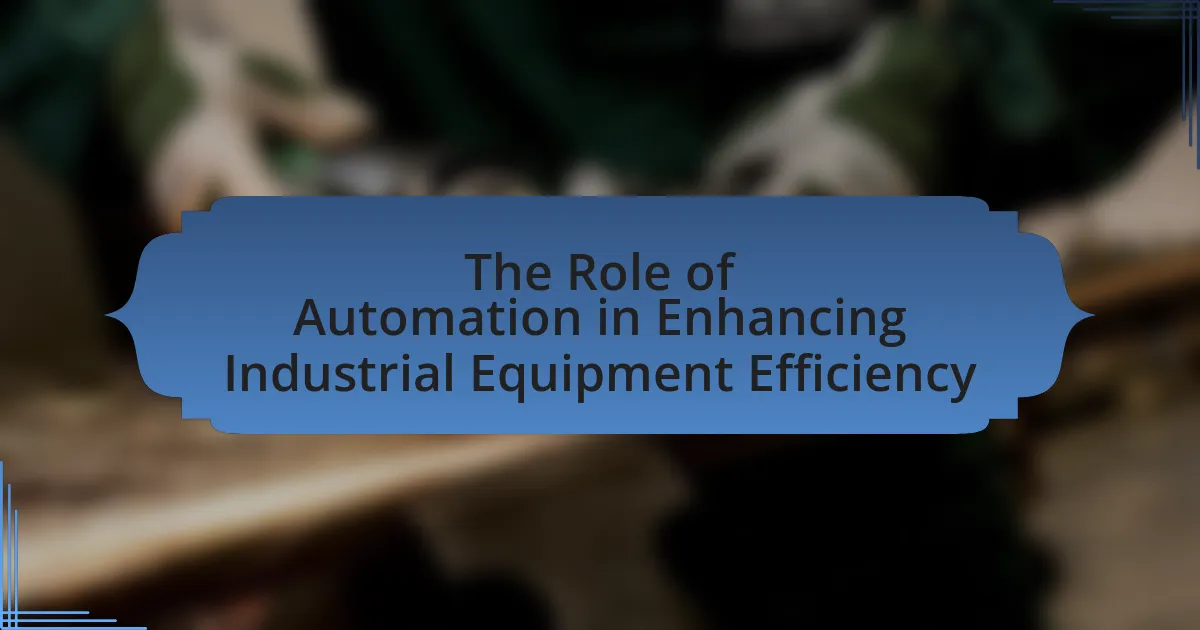The article examines the impact of Industry 4.0 on industrial equipment development, highlighting the integration of advanced technologies such as the Internet of Things (IoT), artificial intelligence (AI), and big data analytics. These technologies enhance efficiency, enable predictive maintenance, and facilitate customization, leading to significant productivity gains and reduced costs. Key benefits include improved operational processes, enhanced equipment performance, and increased flexibility in production. The article also addresses challenges such as cybersecurity concerns and workforce skill gaps, while outlining future trends and best practices for successful integration of Industry 4.0 in equipment development.
What is the Impact of Industry 4.0 on Industrial Equipment Development?
Industry 4.0 significantly enhances industrial equipment development by integrating advanced technologies such as IoT, AI, and automation. These technologies enable real-time data collection and analysis, leading to improved efficiency, predictive maintenance, and customization of equipment. For instance, a report by McKinsey indicates that companies adopting Industry 4.0 technologies can achieve productivity increases of up to 30%. Furthermore, the use of digital twins allows for virtual simulations of equipment, facilitating better design and testing processes before physical production. This transformation not only accelerates innovation but also reduces costs and time-to-market for new industrial equipment.
How does Industry 4.0 redefine industrial equipment development?
Industry 4.0 redefines industrial equipment development by integrating advanced technologies such as the Internet of Things (IoT), artificial intelligence (AI), and big data analytics into the design and manufacturing processes. This integration enables real-time data collection and analysis, leading to enhanced efficiency, predictive maintenance, and customization of equipment. For instance, IoT sensors can monitor equipment performance continuously, allowing for timely interventions that reduce downtime and maintenance costs. According to a report by McKinsey, companies that adopt Industry 4.0 technologies can achieve productivity gains of 20-30%. This transformation not only optimizes operational processes but also fosters innovation in product design and functionality, aligning equipment development with evolving market demands.
What technologies are driving the changes in industrial equipment?
The technologies driving changes in industrial equipment include the Internet of Things (IoT), artificial intelligence (AI), robotics, and advanced data analytics. IoT enables real-time monitoring and control of equipment, enhancing operational efficiency and predictive maintenance. AI algorithms optimize processes and improve decision-making by analyzing vast amounts of data. Robotics automates repetitive tasks, increasing productivity and safety in manufacturing environments. Advanced data analytics provides insights that lead to better resource management and operational strategies. These technologies collectively contribute to the evolution of industrial equipment, aligning with the principles of Industry 4.0, which emphasizes smart manufacturing and interconnected systems.
How do these technologies enhance equipment performance?
Technologies associated with Industry 4.0 enhance equipment performance by integrating advanced data analytics, IoT connectivity, and automation. These technologies enable real-time monitoring and predictive maintenance, which significantly reduce downtime and increase operational efficiency. For instance, a study by McKinsey & Company found that predictive maintenance can reduce maintenance costs by 10-40% and increase equipment uptime by 5-10%. Additionally, the use of smart sensors allows for continuous performance tracking, leading to optimized processes and improved product quality.
What are the key benefits of Industry 4.0 for industrial equipment?
The key benefits of Industry 4.0 for industrial equipment include enhanced efficiency, improved predictive maintenance, and increased flexibility in production processes. Enhanced efficiency is achieved through automation and real-time data analytics, which optimize operations and reduce downtime. Improved predictive maintenance leverages IoT sensors and data analytics to anticipate equipment failures before they occur, thereby minimizing unplanned outages and maintenance costs. Increased flexibility allows for more adaptable manufacturing processes, enabling companies to quickly respond to market changes and customize products to meet specific customer demands. These benefits collectively contribute to higher productivity and competitiveness in the industrial sector.
How does Industry 4.0 improve efficiency in equipment development?
Industry 4.0 improves efficiency in equipment development by integrating advanced technologies such as IoT, AI, and big data analytics into the design and manufacturing processes. These technologies enable real-time monitoring and data collection, which facilitate predictive maintenance, optimize resource allocation, and enhance collaboration across teams. For instance, a study by McKinsey & Company highlights that companies implementing Industry 4.0 technologies can achieve up to a 30% reduction in time-to-market for new products, demonstrating significant efficiency gains in equipment development.
What role does data analytics play in optimizing industrial equipment?
Data analytics plays a crucial role in optimizing industrial equipment by enabling predictive maintenance, enhancing operational efficiency, and reducing downtime. By analyzing data collected from equipment sensors and operational processes, organizations can identify patterns and anomalies that indicate potential failures before they occur. For instance, a study by McKinsey & Company found that predictive maintenance can reduce maintenance costs by 10-40% and decrease equipment downtime by 50%. This data-driven approach allows for timely interventions, ensuring that industrial equipment operates at peak performance and extends its lifespan.
What challenges does Industry 4.0 present to industrial equipment development?
Industry 4.0 presents several challenges to industrial equipment development, primarily due to the integration of advanced technologies such as IoT, AI, and big data analytics. These technologies require significant investment in new infrastructure and skills, which can strain existing resources. Additionally, the complexity of ensuring interoperability between legacy systems and new technologies complicates the development process. Security concerns also arise, as increased connectivity exposes equipment to cyber threats, necessitating robust cybersecurity measures. Furthermore, the rapid pace of technological change demands continuous adaptation and innovation, which can overwhelm traditional development cycles.
How do cybersecurity concerns affect equipment development?
Cybersecurity concerns significantly influence equipment development by necessitating the integration of robust security features into the design and functionality of industrial equipment. As Industry 4.0 emphasizes connectivity and data exchange, equipment must be designed to withstand potential cyber threats, which can lead to increased development costs and longer timelines. For instance, a report by the World Economic Forum highlights that 60% of manufacturers have experienced cyber incidents, prompting them to prioritize cybersecurity in their development processes. This shift results in the adoption of secure coding practices, regular software updates, and the implementation of advanced encryption methods, ultimately shaping the overall architecture and capabilities of new equipment.
What are the implications of workforce skill gaps in Industry 4.0?
Workforce skill gaps in Industry 4.0 lead to decreased productivity and innovation within organizations. As industries increasingly adopt advanced technologies such as automation, artificial intelligence, and the Internet of Things, the demand for skilled workers who can operate and maintain these systems rises significantly. According to a report by the World Economic Forum, 85 million jobs may be displaced by a shift in labor between humans and machines by 2025, highlighting the urgent need for reskilling and upskilling initiatives. Furthermore, companies face challenges in meeting customer demands and maintaining competitive advantage due to a lack of qualified personnel, which can result in stalled projects and increased operational costs.
How does Industry 4.0 influence the lifecycle of industrial equipment?
Industry 4.0 significantly influences the lifecycle of industrial equipment by integrating advanced technologies such as IoT, AI, and big data analytics, which enhance monitoring, maintenance, and operational efficiency. These technologies enable real-time data collection and analysis, allowing for predictive maintenance that reduces downtime and extends equipment lifespan. For instance, a study by McKinsey & Company indicates that predictive maintenance can reduce maintenance costs by 10-40% and increase equipment availability by 10-20%. This shift from reactive to proactive maintenance strategies fundamentally alters how industrial equipment is managed throughout its lifecycle, leading to improved performance and reduced total cost of ownership.
What changes occur in the design phase of equipment development?
In the design phase of equipment development, significant changes include the integration of advanced technologies such as IoT, AI, and data analytics. These technologies enhance design efficiency, enable real-time monitoring, and facilitate predictive maintenance. For instance, the use of AI algorithms allows for optimized design processes by simulating various scenarios and outcomes, leading to improved product performance and reduced time-to-market. Additionally, IoT devices provide continuous feedback during the design phase, allowing for iterative improvements based on actual usage data. This shift towards a data-driven approach in design reflects the broader impact of Industry 4.0 on industrial equipment development, emphasizing agility and responsiveness to market demands.
How does Industry 4.0 affect maintenance and support of industrial equipment?
Industry 4.0 significantly enhances the maintenance and support of industrial equipment through the integration of smart technologies such as IoT, AI, and big data analytics. These technologies enable predictive maintenance, allowing for real-time monitoring of equipment conditions, which reduces downtime and maintenance costs. For instance, a study by McKinsey & Company found that predictive maintenance can reduce maintenance costs by 10-40% and increase equipment uptime by 5-10%. This shift from reactive to proactive maintenance strategies leads to improved operational efficiency and extends the lifespan of industrial equipment.
What future trends can we expect in industrial equipment development due to Industry 4.0?
Future trends in industrial equipment development due to Industry 4.0 include increased automation, enhanced connectivity, and the integration of artificial intelligence. Automation will lead to more efficient production processes, as machines will be able to operate with minimal human intervention, resulting in reduced labor costs and increased output. Enhanced connectivity through the Internet of Things (IoT) will allow for real-time data exchange between machines, enabling predictive maintenance and improved operational efficiency. The integration of artificial intelligence will facilitate advanced analytics, allowing for smarter decision-making and optimization of production workflows. These trends are supported by the fact that, according to a report by McKinsey, companies that adopt Industry 4.0 technologies can increase productivity by up to 30%.
How will emerging technologies shape the next generation of industrial equipment?
Emerging technologies will significantly shape the next generation of industrial equipment by enhancing automation, connectivity, and data analytics capabilities. Technologies such as the Internet of Things (IoT), artificial intelligence (AI), and advanced robotics will enable equipment to operate more efficiently and autonomously. For instance, IoT sensors can provide real-time data on equipment performance, allowing for predictive maintenance and reducing downtime. According to a report by McKinsey, companies that adopt IoT in their operations can achieve up to a 30% reduction in maintenance costs. Furthermore, AI algorithms can optimize production processes by analyzing vast amounts of data, leading to improved decision-making and resource allocation. This integration of emerging technologies will ultimately result in smarter, more adaptable industrial equipment that meets the demands of modern manufacturing environments.
What role will sustainability play in future equipment development?
Sustainability will play a critical role in future equipment development by driving the design and manufacturing processes towards environmentally friendly practices. As industries increasingly adopt Industry 4.0 technologies, such as IoT and AI, equipment will be developed with a focus on energy efficiency, reduced waste, and the use of sustainable materials. For instance, a report by the World Economic Forum highlights that integrating sustainable practices can lead to a 30% reduction in resource consumption in manufacturing processes. This shift not only meets regulatory requirements but also aligns with consumer demand for greener products, ensuring that future equipment is both innovative and responsible.
What best practices should companies adopt for successful integration of Industry 4.0 in equipment development?
Companies should adopt a holistic approach that includes embracing digital transformation, fostering collaboration, and investing in employee training for successful integration of Industry 4.0 in equipment development. Digital transformation involves implementing advanced technologies such as IoT, AI, and big data analytics to enhance equipment functionality and efficiency. Collaboration across departments and with external partners is crucial to ensure that insights and innovations are shared, leading to improved product development. Additionally, investing in employee training equips the workforce with the necessary skills to operate and maintain new technologies, which is essential for maximizing the benefits of Industry 4.0. These practices are supported by studies indicating that organizations that prioritize digital skills and collaborative environments see a significant increase in productivity and innovation rates.




